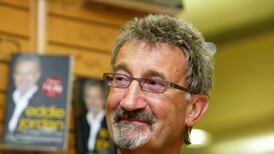Melanie Stewart (nee le Brocquy)
Born: December 23rd, 1919 (98)
Died: June 22nd, 2018
It was perhaps inevitable that the artistic career of Melanie le Brocquy, who has died aged 98, should have been overshadowed by that of her more famous brother, Louis, widely regarded as one of Ireland’s greatest painters. He was far more prolific than his sister and, crucially, worked in a medium, painting, which was always more popular with the art-buying public, at least in Ireland, than her chosen field of sculpture.
Le Brocquy, whose married surname was Stewart, also worked in a very small scale, her figures being what this newspaper’s former art critic Brian Fallon, writing in a 1990 interview, called “inches rather than feet”, something which perhaps further limited her appeal.
However, there is little doubting its sheer quality, something recognised by her election as an honorary member of the Royal Hibernian Academy in 1989, and her earlier election to Aosdána in 1981. From the very beginning of her career in the late 1930s, while still a student at what became the National College of Art and Design (NCAD), she garnered distinguished prizes, starting with two Taylor Scholarship awards and the California Gold Medal from the Royal Dublin Society (RDS) for pieces successfully entered for the RHA Annual Exhibitions of 1938 and 1939, through to the Sculpture Prize of the RHA in 1995, which was followed by a major retrospective exhibition there in 1999.
Melanie le Brocquy’s work is unmistakably modernist in its themes of picturing the lives of ordinary people in ordinary situations, or sometimes extraordinary people rendered in a very human style, as with her sculpture of Lady Gregory seated beneath her Catalpa tree, referenced only by some fallen leaves at her feet.
Writing in this newspaper of that retrospective of 1999, Aidan Dunne described her sculpture as “subtle and understated; it … is forthrightly domestic in scale,” adding that “while her figure studies are characterised by detailed observation, it is not observation in the academic sense of the exhaustive study of anatomical structure. With le Brocquy, it’s more a question of noticing small gestures, momentary movements and attitudes, like vivid details glimpsed in the corner of your eye”.
Chicken wire
Le Brocquy’s mother, Sybil, was a writer and frequent guests at their home in Dublin’s Rathgar included WB and George Yeats, Austin and Nora Clarke and Kate O’Brien among many other luminaries of Dublin cultural life in the 1930s. Initially, her parents (her father Albert, a Company Secretary) had wanted her to attend university, but she followed Louis to art school and, using the Taylor Scholarship funds, went on an extended trip to Europe in 1938-1939, which included taking classes at the Louvre and the Musée Rodin in Paris, and at the Ecole des Beaux Arts, Geneva.
In the early 1940s, she and her brother exhibited together in 1942, and the following year also at the first exhibition of the influential Living Art movement in Dublin. However, after her marriage, aged 24, to Stanley Stewart, a bacteriologist in the medical school of Trinity College, Dublin, she entered a long period of artistic silence which included having four children. It was not until nearly 20 years later that she started once again to exhibit.
Initially working in plasticine, and experimenting with chicken wire and Plaster of Paris for her working models – she never worked from drawings – le Brocquy was influenced by the work of then-emerging English sculptors she had seen on television, and received much encouragement from friends and fellow artists including the architect Michael Scott, the German sculptor Werner Schurmann, and his Czech-born wife, also a sculptor, Gerda Fromel, Oisin Kelly and Edward Delaney. Schurmann compared le Brocquy's style in this period to that of Giacometti after seeing her Crucifix, which was exhibited at the Salzburg Biennale in 1962.
Turning point
A pivotal moment was a trip she undertook with her husband, who had been awarded a travelling fellowship, to the USA in 1966, where she saw works exhibited in galleries in New York, Boston, Los Angeles, Washington, DC, and San Francisco. In her 1990 interview with Brian Fallon, she described this as “a turning point of my existence”.
Thereafter, and working with various materials, but, interestingly only once with stone, she exhibited regularly in Dublin, London and Belfast, and had five solo shows in a six-year period after 1986. Le Brocquy maintained a high degree of artistic and personal integrity in this, telling Hilary Pyle in a 1997 interview that she had withdrawn from the competition for the statue of Oscar Wilde in Merrion Square in Dublin “when I realised that the time for completing the sculpture was too short”.
Brian Fallon, writing in 1990, had noted the same characteristic: “Melanie le Brocquy is a slow, fastidious worker, and nothing goes for casting unless she is entirely satisfied; even then, a tiny piece may undergo a lot of refining and tinkering until she feels it looks just right.”
Later, she made a bust of Wilde, whom she admired, cast in a set of four, which are now in, respectively, the Irish embassy in Washington, Trinity College, Dublin, Magdelen College, Oxford and the American College located in Wilde’s childhood home at number 1 , Merrion Square.
Melanie Stewart, nee le Brocquy, was predeceased by her husband and her brothers Louis and Noel, and is survived by her four children, Kathryn, John, Bruce and Caroline.














